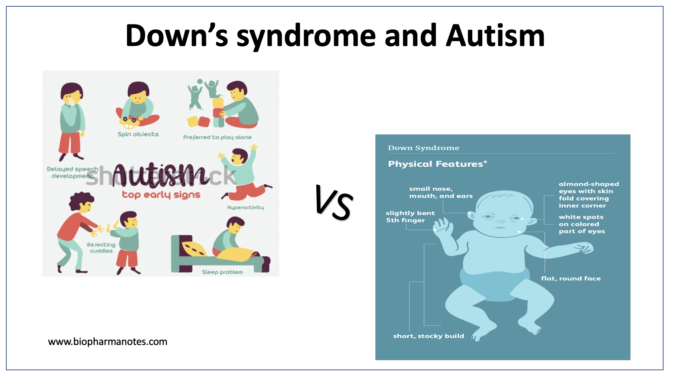
- To understand the difference between down syndrome and autism, we have to first understand what down syndrome and autism mean. Down syndrome and autism spectrum disorder (ASD) though have some common symptoms and may coexist, they are completely different conditions with different causes, symptoms, diagnosis, and treatment.
Definitions of Down Syndrome and Autism
- Down syndrome (DS) which is also termed as trisomy 21 is a genetic disorder in which a person has an extra chromosome (third copy of chromosome 21). People with DS have mild to moderate IQ range. 1 of 800 births may have DS, worldwide.
- Autism spectrum Disorder (ASD) is a set of neurodevelopmental disorder characterized by lack of social interaction, problems in verbal and non-verbal communication, speech, and motor skills. It is considered as multi-factorial disorder which may occur due to genetic and non-genetic risk factors and their interaction.
Signs and Symptoms of Down Syndrome and Autism
People with DS may show some common symptoms like:
- A flattened face, especially bridge of the nose.
- Almond shaped, upward slanted eyes with short neck.
- Small ears, small hands and feet and bulging tongue.
- Poor muscle tone and loose joints.
- Vision disorder and loss of hearing.
- Obstructive sleep apnea.
- Obesity and immune deficiency.
- In some children, heart defects may be present from birth.
People with ASD may show following symptoms:
- Impaired communication.
- Repetitive actions and compulsive behavior. They may have difficulty in adaptation when their routine changes.
- Impaired social interaction (very interested in people but don’t know how to talk or relate with them, unaware when people talk with them, don’t prefer to be hugged or cuddled and may hug only if they want).
- Abnormal eating and sleeping pattern.
Types
- There are three different types of ASD namely autistic disorder (classic autism), pervasive developmental disorder (atypical autism) and asperger syndrome.
- Down’s syndrome is of three different types, namely trisomy 21, mosaic down syndrome and Robertsonian translocation.
Diagnosis
- DS can be diagnosed during pregnancy using two tests: screening and diagnostic test. Screening test can help to determine whether the female’s pregnancy has higher or lower chances of having DS. It is safe both for mother and fetus. However, it may not provide absolute diagnosis. Diagnostic test can help to detect whether baby will have DS. However, it may be risky both for mother and fetus. Screening test consists of blood test and ultrasound. Diagnostic tests consist of amniocentesis, chorionic villus sampling and percutaneous umbilical blood sampling.
- There is no particular medical test for autism. It cannot be diagnosed during pregnancy. It is diagnosed by looking at child’s development and behavior.
Treatment
- No medial cure is available for Down’s syndrome. Early medical support and developmental interventions like speech, physical and occupational therapy may be helpful for many children. In recent decades life expectancy and quality of DS patients have significantly improve with the help of antibiotics, vaccinations, cardiac surgery, anticonvulsive drugs, and leukemia treatment.
- ASD cannot be completely cured. It is usually managed by various educational and behavioral treatment. Early intervention treatment may be helpful in improving child’s development. Various pharmacological treatment includes antipsychotics, antidepressants, mood stabilizers, anticonvulsant, SSRIs (Selective Serotonin Reuptake Inhibitors) etc. Pharmacological agents should be chosen based on specific individual behavioral, physical, or psychiatric conditions like OCD (obsessive compulsive disorder), mood disorder and schizophrenia. Intervention therapy like DBS (deep brain stimulation) has been used since its FDA approval in 1997.
References
- Park HR et al. A Short Review on the Current Understanding of Autism Spectrum Disorders. Exp Neurobiol. 2016 Feb; 25(1): 1–13
- Kazemi M etal. Down Syndrome: Current Status, Challenges and Future Perspectives. Int J Mol Cell Med. 2016 Summer; 5(3): 125–133.
- Hopper AH. Down syndrome. NEJM. 2020; 382: 2344-52.
- https://www.cdc.gov/ncbddd/autism/facts.html